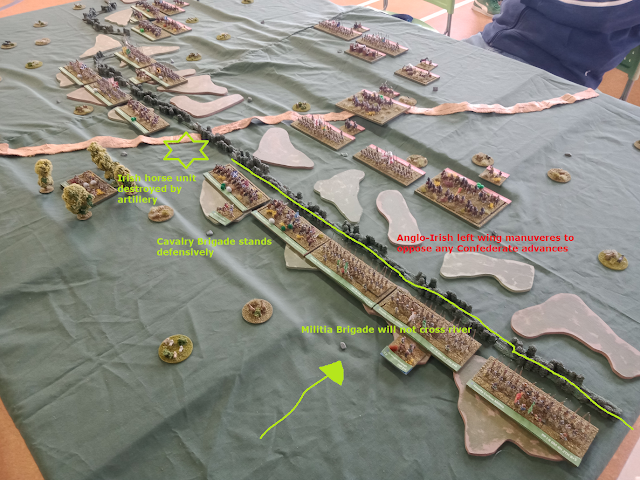The rebellion in Ireland that had began in October 1641 showed few signs of slowing down in early 1643 as the various factions prepared for another years campaigning.
The Irish Confederates had become a much more organised force since the early days of the rebellion. Under the Confederation of Kilkenny, which was formed in mid 1642, four regional armies were created as the basis of the Confederates armed forces.
One of the regional armies was based in Leinster. In 1643 this was under the command of Thomas Preston, an experienced professional soldier. Like several other Irish commanders Preston had entered service in the Spanish army and had served in Europe during the 30 years war before returning to Ireland to take part in the rebellion against Charles 1st's rule.
Charles's rule in Ireland was administered by the Lord Lieutenant of Ireland, Richard Butler, the Marquis of Ormonde. Ormonde was under orders to take action against the Confederate forces in Leinster so in early March 1643 he marched from Dublin with a force of around 4000 men, including a large artillery park. His aim was to take control of the important Confederate garrison town of New Ross, some 120km south of Dublin. New Ross was central to the Confederate's logisitics and supply arrangements for their Leinster Army, so Ormonde hoped to capture as much material as he could to boost his own limited resources.
However, Ormonde's plan did not come to fruition, as although he laid seige to the town and conducted a artillery bombardment the Confederate garrison held on, reinforced by contingents bought in via the River Barrow.
Aware that Preston was gathering his forces nearby Ormonde decided to return to Dublin. His forces begain the march back to the Irish captial, but on the morning of 18 March 1643, near the small village of Ballinvegga they found the road blocked by Preston's Leinster army of some 6,000 men.
Paul and I recently played a test game of Bill Linhart's Ballinvegga scenario for our upcoming Irish scenario book we are putting together using "For King and Parliament" rules, along with our optional Celtic Fringe add-on rules.
The deployed armies were set up as illustrated below. The smaller Anglo-Irish force must use its artillery to assist in clearing the Confederate forces away from the road exit which the Anglo-Irish must hold in order to continue their return journey to Dublin. To win the larger Confederate force must attempt to capture the Anglo-Irish artillery and prevent any enemy units from holding the road exit for a turn.
My plan as the Confederate player was to attempt a double envelopment of the Anglo-Irish artillery using my two large infantry brigades and left wing horse while defending the road exit and the centre with the other cavalry brigade.
However this plan did not develop well when both infantry brigades drew 1's trying to brigade move on the first turn. Only my left wing cavalry, directed by Preston himself were able to advance, while the Anglo-Irish artillery chipped away at the cavalry in the centre. Eventually O'Bryne's foot brigade on the left did advance across the river. The Anglo-Irish right wing horse moved to counter my move, resulting in even honours with one unit of each side being destroyed. Preston had a lucky escape, being hit but only incurring a manly scar from a Anglo-Irish blade during the melee. He quickly sought refuge with O'Bryne's brigade as my victorous cavalry unit pursued its beaten foe right off the board eventually.
The right wing turned into a bit of a Mexican standoff as my raw, pure pike armed militia brigade had no firepower and could not actually charge the Anglo-Irish horse if they wished to, but this turned out to be academic as they only activated in one turn, every other draw being a 1 or a 2! So they never got to advance beyond the river anyway. Paul's artillery eventually managed to inflict a second disorder on a unit of Irish horse before they expended all their ammunition, which was enough to remove them.
But was on the left that the game was decided. Intent on trying to advance up the hill towards the enemy artillery O'Byrne's infantry was soon confronted by several Anglo-Irish units on three sides. Paul advanced the Lord President's regiment and destroyed one of O'Byrne's pike heavy battalia, while the commander in chief in person and his impressive looking bodyguard also advanced down the road. The real game changer came as Paul managed to rally his pursuing horse (as the brigade commander was present) and then subsiquently triple activate to arrive at the exit point completely unopposed and hold it for a turn.
The destruction of the foot battalia was also the end of my victory medals, so the Anglo-Irish mirrored the historical result with a well deserved win.
On to one of the more well-known Irish battles of the period next as we travel to the banks of the Blackwater River where O'Neill's Confederates face Monro's Anglo-Scots at Benburb in 1646.




Thank you for another enjoyable account of a battle entirely new to me. I look forward to seeing your scenario book in due season.
ReplyDeleteThanks Kim. Many of the Irish battles are not as well known as some of the battles fought in England and Scotland during this periods. We are working with Simon Miller with a view to releasing our Irish scenario book by the end of 2024.
ReplyDelete